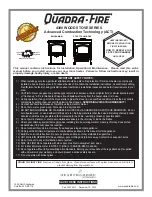
5
Planning Installation
Safety and General
Installation
Operation
Maintenance
Troubleshooting
Parts / Accessories
This appliance is not designed to be operated in a negative pressure.
In very airtight homes with large kitchen exhaust fans, furnace cold air
returns, fresh air exchange systems and any other air system in close
proximity to the heating appliance may create a negative pressure in the
same room as the heating appliance. This can create dangerous back
drafting of the stove and chimney joints, drawing combustion by-products
into the home. Be sure your home has adequate makeup air to eliminate
negative pressures caused by the above-mentioned sources. Outside
air connected to the appliance probably will not resolve such a problem
as the appliance is not the source of negative pressure. IHP accepts no
liability for damages resulting from negative pressures described here.
Ventilation Requirements
- Provide adequate air for combustion. The
fresh air requirements of this appliance must be met within the space
where it will be installed. Ventilation is essential when using a Solid-Fuel-
Burning heater. In well insulated and weather tight homes, it may be
difficult to establish a good draft up the chimney (caused by a shortage
of air in the home). The lack of air is caused by many common household
appliances which exhaust air from the home (such as a furnace, heat
pump, air conditioner, clothes dryer, exhaust fans, fireplaces, and other
fuel burning appliances). Also, the combustion process of this heater
uses oxygen from inside the dwelling. If the available fresh air delivery
in the dwelling is insufficient to support the demands of these appliances,
problems can result (e.g. excessive negative pressure can develop in the
dwelling which will affect the rate at which this appliance can draft thus
resulting in performance problems). To correct this problem it may help
to open a window (preferably on the windward side of the house) or install
an optional outside air kit.
CHIMNEY HEIGHT REQUIREMENTS
NEGATIVE PRESSURE WARNING
Figure 1 - Chimney Height Requirements
Less than
10' (3 m)
10'
(3 m)
3' (914 mm)
Min.
2’ (610 mm) Min.
(914 mm)
Min.
3'
To pass inspection in nearly any jurisdiction, the chimney must meet both
safety and exhaust flow requirements. The (3’ by) 2’ by 10’ rule applies
to both masonry and factory-built chimneys.
* Ref. USA - National Standard, NFPA 211-latest edition and Canada
National Standard CSA B365-01-latest edition. Vents installed with a
listed cap shall terminate in accordance with the terms of the cap’s
listings.
Planning Installation
The chimney must extend 3’ (.92m) above the level of roof penetration
and a minimum of 2’ (.61m) higher than any roof surface within 10’
(3m) (see below). Check with your local building officials for additional
requirements for your area.
Safety and General






































